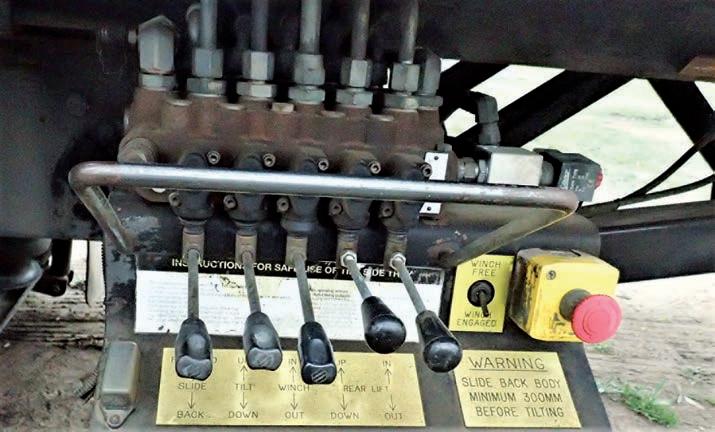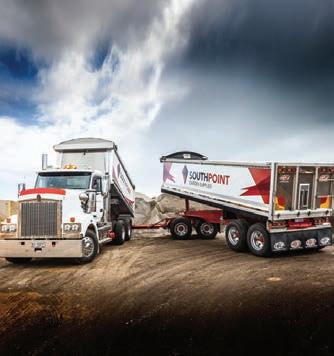
25 minute read
Australian Road Transport Suppliers’ Association
from Prime Mover May 2020
by Prime Group
PETER HART
Iwant to explain the basics about truck and trailer hydraulic systems for lifting, rotating and pushing and pulling applications. This article concerns working systems that are not part of the original equipment design. Therefore, they are the responsibility of a modifier. Generally, they are not covered by the Australian Design Rules or inservice vehicle standards regulations. However, there are occupational work safety regulations that must be complied with and there are some safe-practice principles that should be followed. Installation of a hydraulic system is not a recognised modification in National Heavy Vehicle Modification Code (VSB 6). Hydraulic systems use oil flow and pressure to transfer energy and do work. The oil is essentially incompressible. That’s different to pneumatic systems where compression of air is a factor. There are four pressure numbers that are important for any hydraulic system: • Atmospheric pressure – 1 Bar • Neutral pressure – This is the pump outlet pressure when the system is not working but is circulating oil. This pressure should be less than 20 Bar. • Working pressure or pump operating pressure – this is the pressure required to accomplish work. It can be 140 Bar, which is twenty times the maximum pneumatic (brake air tank) pressure. • Relief Pressure – the pressure at which the relief valve opens and
The basics of truck hydraulics
bleeds pressure back to the reservoir. It is usually set at 15 per cent above working pressure. • Burst Pressure – the pressure at which a vulnerable component (such as a hose) will burst. This should be at least four times the Working pressure. The braided hydraulic hose that transfers hydraulic oil to moving parts must withstand pressure changes during operation between Neutral and Working pressure. The hoses experience pressure pulses so they expand and contract. Hoses vibrate and jiggle around. The stresses of this are felt at the end fittings which are fixed. Hoses need to be secured so that they do not rub and do not crack at the end fitting. Hoses must be correctly sized for the working flow rate. Too small and the pressure drops are great. Too large and the hose is hard to install and bend. The larger the hose diameter, the greater the expansion force to be resisted. Hoses have two ratings, which are Working Pressure and Burst Pressure. As a guide Burst = 4 x Working pressure. The hydraulic pump is often driven by a Power Take Off (PTO) that is installed into the gearbox. The pump probably produces an output flow rate that is proportional to PTO speed. Consequently, the flow must return to the reservoir when in Neutral (idling). However, there are pump types called load sensing pumps that change flow rate according to conditions. Directional or Spool Valves direct hydraulic oil into actuators (cylinders, pumps) to do useful work. Once the Cylinder is extended or retracted, the hydraulic pressure is either locked in by a control valve or it is released by a bypass valve and flows back to the reservoir. Directional valves can be either Open Centre or Closed Centre. In an Open Centre valve the oil flow is continuous and it is routed through a central passageway (Neutral conditions) and back to the reservoir unless a spool in the valve is ‘stoked’ (moved) and the flow is directed towards a load. The oil flow is maintained. The pump

pressure must rise to overcome the load and move. Open centre systems have continuous flow and intermittent pressure. In a Closed Centre system, the oil flow is intermittent, and the pressure is constant. Under Neutral conditions only flow is produced to maintain a standby pressure at the direction control valve. When a spool is ‘stoked, a pathway for flow is revealed and the pump is signalled to increase the flow. Three-way direction valves are used to control power-up, gravity-down cylinders. In the Neutral position the pressure in the cylinder is locked until the valve is moved to the release position where oil can flow back out of the cylinder. Four-way direction valves are used to power-up and power-down cylinders. Valves used for controlling motors must have a ‘free-flow’ or motor feature that allows the oil from the motor that is being driven by a load to circulate to avoid damaging the motor. The lifting force of the cylinders is Working Pressure x Cylinder Inner Area. Note that the flow rate can be adjusted via the variable orifice. Reservoirs are closed tanks that are usually made of steel or aluminium. Aluminium has about three times the heat dissipation capacity of steel and is lighter but is harder to fabricate. Heat dissipation is necessary because the hydraulic oil heats up as it does work. The oil return port must be low down to avoid frothing the oil in the tank. The oil return port should also be away from the intake port to avoid circulation of hot oil. The tank will need a breather to cope with oil level changes. Keeping the oil topped up will minimise the air space and therefore minimise the condensation moisture that can get into the oil. Contamination is the greatest enemy of hydraulic systems. An unclogged filter must be in the lowpressure pump intake. A suction strainer should also be installed in the reservoir to catch larger debris. The filter should be placed before the cooler to prevent clogging. Safety Valves must be fitted
Direction valve unit on a tilt tray tow truck. Note the identifiers and the Emergency Stop.

on lifting cylinders that are used on tip trucks, tilt trays and bin hooks. The valve prevents oil loss under gravity if the outlet is open, that is if the outlet hose has burst. The valve is fitted directly to the cylinder, as shown in the photo. A ‘burst valve’ installed directly onto a lifting cylinder. Here are some safe practice requirements for hydraulic systems: 1. The safety of a person should not depend only on the hydraulic system working. There must be a second independent protection. On tip trucks there must be a safety leg and a safety valve on the lifting cylinder. 2. The controls must be identified with words, arrows or symbols so the operator knows what response will occur to a control movement. 3. There must be an emergency stop that can be activated away from the control location. 4. The failure of a hydraulic hose should not create a hazard. 5. Never face the outside of a hose bend towards the operator because if it comes off it could hit him/her. 6. Do not twist hydraulic hoses. A 10° twist will shorten life by 90 per cent! 7. Manufacturer’s minimum hose bend radius must be met. Otherwise the ends will fail prematurely. 8. Route hoses so they flex in one plane only. The printed “lay line” should stay in one plane only. 9. Hoses should not be tight. Parts of vehicles move relative to each other and this will stress the hose. 10. For long runs metal tubing is preferred over hoses. Steel must be plated but not galvanised because the later can flake off. 11. Avoid locating hydraulic hoses or fittings near to unshielded exhaust pipes. If the hose or an end fitting fails, a fire will probably occur. 12. Do not use Teflon tape on NPT (tapered) fittings. The Teflon tape may get inside the system. 13. Restriction of oil flow into the pump can cause cavitation, which releases wear particles into the hydraulic system. These will clog the direction valves. 14. Safety valves must be used on a cylinder when hose failure can cause a lifted load to fall. 15. Hot oil degrades system components. A satisfactory operating temperature is 60 o C.
Note that work safety regulations require the designers and installers of plant to conduct a hazard risk assessment. This applies to vehicles!
The 101 articles are available at www.arsta.com.au/articles
SUBSCRIBE AND SAVE!
September 2019





October 2019

® A U S T R A L A S I A’ S T R A I L E R I N D U S T R Y R E S O U R C E A U G U S T 2 0 1 9 CHAIN REACTION LINKING INDUSTRY WITH INNOVATION ® A U S T R A L A S I A’ S T R A I L E R I N D U S T R Y R E S O U R C E S E P T E M B E R 2 0 1 9
MAXIMUM GAINS BUILDING THE BEST AUSTRALIAN EQUIPMENT
Qube Logistics New Frontiers Tow Trucks Brisbane First on the Scene





52 september 2017 Innovation Fleet: LogicHaul Test Drive: Hino 500 Sustainability: Michelin Automation: Goodyear ISSN 1838-2320 9 771838 232000 11 SEPTEMBER 2019 $11.00 Industry Fleet: McMahon Services Feature: Cabin Fever Movers & Shakers: Jim Temple Personality: Hugh McMaster T H E P E O P L E & P RO D U C TS T H AT M A K E T R A N S P O RT M OV E COVER STORY 26 december 2018 primemovermag.com.au 27 order to comply with more than the usual Commonwealth, State and local regulations and has resulted in an ultrahigh technology facility that is covered by 69 safety and security cameras and extensive on-site fire detection and fire fighting systems. The authorities are anxious to prevent any incidents that could affect the operation of the airport so there is a continuous sampling of air to detect any smoke and the entire fire and security system is tamper monitored. The warehouse has nine robotic doors, which will open in the event of a fire to vent any smoke. The warehouse has a footprint of 11,000 square metres of which 50 per cent is refrigerated in four different temperature zones using a very efficient refrigeration plant that utilises ammonia rather than the more common Freon. The move from QFS’s previous premises in Stafford required 5,000 pallets to be moved in a 72 hour period and as the QFS fleet needed to continue to deliver goods to customers, contractors were engaged to handle the 120 trailer loads of products. A distinct point of difference between QFS and other food service suppliers is the extensive and ever increasing range of gourmet items that it has available including boutique nonalcoholic beverages. The beverage sector is a growing market and drinks now account for around 10 per cent of sales with almost 700 different beverage products available. The warehouse holds bay after bay of food service products that are not readily available in retail supermarkets and are required by catering, hospitality and cooked food outlets. One of the advantages of expanding the beverage business is the opportunity to cross sell food service products to those on the beverage customers’ base. “With beverages we don’t deal with the chef as we often do with food products,” says Brian Saharin, QFS General Manager. “Instead we deal with the front of house.” This opens the possibility to provide ancillary items such as napkins, coasters and straws and customers who were predominantly beverage clients are now able to obtain food service products as well. This also translates into the opportunity for traditional food customers to amalgamate their beverage and food orders. QFS Company Director Guy Politi says that there is a trend in demand towards some higher quality food and beverages. “It can be tomato paste from Italy or cooking oil from Malaysia. We import a lot of quality gourmet products such as flour, rice and confectionery,” Guy says. The truck brand of choice at QFS is Hino, mostly the wide body 500 Series with 260 horsepower engines and Allison automatic transmissions. Trucks that have entered the QFS fleet as assets of various business acquisitions will be progressively replaced with more Hinos to join the 39 Hinos that are already in the fleet. The decision to adopt Hino as W hen company CEO Frank DePasquale established Quality Food Services (QFS) in 1988 the two main products were lasagne and hot dogs and were mostly sold to school canteens. Today QFS has a range of over 7,000 products, which it delivers to businesses such as restaurants, pubs, clubs, hotels, cafes, and aged care facilities. And QFS continues to supply a wide range of products to approximately 800 schools. Providing direct service to an area extending from Cooroy on the Sunshine Coast to Ballina in northern New South Wales, and west to Toowoomba, QFS is also involved in providing food services to remote mining camps using sub-contractors. During late 2018, in order to handle the volume and to cater for future growth, QFS moved into its purpose designed and built warehouse and administration facility located in Pinkenba in close vicinity to Brisbane Airport. By being directly under the flight path the location presented some unique challenges in QUALITY FOOD SERVICES IS BASED IN BRISBANE AND PROVIDES THE IMPORTANT LINK BETWEEN FOOD AND BEVERAGE MANUFACTURERS AND THEIR WHOLESALE CUSTOMERS. HINO’S WIDE BODY 500 TRUCKS ARE THEIR VEHICLES OF CHOICE FOR THE EXPANDING DELIVERY FLEET. SUPPLYING The truck brand of choice at QFS is Hino, mostly the wide body 500 Series with 260 horsepower engines and Allison automatic transmissions. THE WALLS AND WHEELS Hino 500 series with a 260hp engine. 771838 232000 FLEET primemovermag.com.au 35 S tarting off with a single office in Parramatta, NSW, Pack & Send has evolved into a national delivery heavyweight that can draw on more than 100 service centres Australiawide and was recognised as the Australian Franchisor of the Year in 2007 by PricewaterhouseCoopers and the Franchise Council of Australia. Now also present in the United Kingdom and New Zealand, Pack & Send is considered a leading force in the transport franchise game. Prime Mover met founder Michael Paul, who has been serving as CEO of the company since its incorporation in February 1993.
Q: Pack & Send has been around for a while now. Is the 2016 business still comparable to the one 22 years ago – for example, is parcel delivery still the core of the business?
A: The Pack & Send business has changed tremendously since 1993. We started it before the notion of e-commerce, or even the Internet, was in the vernacular, so there has been a significant shift in the way we function. But our mission has always been the same – providing convenient access to a wide range of solutions when sending anything, anywhere. The types of services we can offer are now more varied, though – from traditional domestic and international import and export work to more modern services, like supporting eBay and online retailers in delivering their products to customers.
Q: How did the parcel delivery industry change since the early days? With Toll IPEC, Star Track and emerging online services like Sendle on the scene, the competition must be fierce.
A: The parcel delivery industry has evolved with the times. For example, customers today expect that a fundamental requirement of parcel delivery services is an online ‘track and trace’ function that provides a real time delivery status. When we started in 1993, no parcel carrier in Australia had that capability as the technology wasn’t yet in place. You had to phone the carrier to find out exactly where your parcel was – and you usually got a response the next day. In the early days, deliveries were also primarily B2B and very few deliveries were made to households. The growth of e-commerce has changed that, with significantly more B2C deliveries. In line with that, the competition has also changed – for example, where Pack & Send once relied either on customers walking in store or phoning us to send their goods, we are now developing new and THERE ARE MANY WAYS TO OPERATE A TRANSPORT BUSINESS IN AUSTRALIA, BUT THE FRANCHISE MODEL IS STILL COMPARATIVELY RARE. MOOREBANK-BASED PACK & SEND HAS PERFECTED THE CONCEPT. THE FLIGHT CENTRE OF PARCEL DELIVERY
FAST FACT According to Pack & Send CEO, Michael Paul, the company’s franchise model is key to ensuring a ‘premium service’ experience. “Our franchisees are our movers and shakers. They’re the faces of the overall business, and of their individual businesses too. As members of the communities they service, they play an integral role in the local marketing of Pack & Send,” he says. In contrast, the role of the franchisor is to provide franchisees with a solid foundation of business systems, or “small business with the tools of a big business,” as Michael puts it. 34 february 2016 Interview by Sebastian Grote Fleet: LogicHaul Test Drive: Hino 500 Sustainability: Michelin Automation: Goodyear Fleet: McMahon Services Feature: Cabin Fever Movers & Shakers: Jim Temple Personality: Hugh McMaster Innovation Fleet: Haulaway Test Drive: Kenworth T410 Final Mile: Toyota HiAce Electric Vehicles: Goodyear ISSN 1838-2320 9 771838 232000 01 SEPTEMBER 2019 $11.00 Industry Fleet: OzWide Freight Feature: Paths of Glory Liquid Waste: Fuso Heavy Personality: Chris Loose T H E P E O P L E & P RO D U C TS T H AT M A K E T R A N S P O RT M OV E






S H O W C A S I N G T H E V E R Y B E S T A U S T R A L A S I A N T R A I L E R A N D B O D Y T E C H N O L O G Y ISSN 1838-2312 9 771838 231003 07 AUGUST 2019 $10.00
M E T A L S P E C I A L T I P P E R S T R A I L E R B U I L D E R E C O N O M Y
N E W S I N D U S T R Y I C O N Modern Road Tanker A N D E Q U I P M E N T N E W S www.trailermag.com.au 37
TRAILER BUILDER
National Manager of Fleet for the Australia Post Group. Vawdrey has built more than half of the national Australia Post trailer fleet, and is the manufacturer of choice when it comes to tautliners. It’s a business partnership that has stood the test of time, extending for more than 30 years. “Vawdrey understands our business and Australia Post understands theirs, in terms of what we can achieve from a productivity perspective and from a timeframe perspective,” adds Terry. “Safety is our number one core value and we don’t compromise on it. That’s part of the reason we only purchase equipment from major manufacturers. We choose our suppliers based around the safety features they can incorporate into our equipment, the large volumes they are capable of producing and their ability to satisfy all of our requirements. “Vawdrey is quite a progressive company from a safety and an innovation perspective. They are always pushing the boundaries in terms of what can be done. They are a very progressive business with regards to producing higher productivity and PBS trailers. With more and more online orders, our freight task continues to grow, so we are moving very large volumes of product.” Thanks to PBS, Australia Post has been introducing a growing number of higher productivity vehicles into the fleet. “This sort of innovation means we can move more freight with less vehicles, helping to get more vehicles off the road. We work within the limits of what the current legislation allows, but we need manufacturers that can support and work within those areas as well, and Vawdrey does just that,” adds Terry. Australia Post’s commitment to safety has never waivered, with the business constantly taking advantage of developing safety technologies to ensure its fleet is as safe as can be. In 2012 for example, Australia Post began implementing anti-lock brakes and stability control across the fleet. “We use Volvo prime movers which we consider to be the safest on the market. The prime movers have anti lock brakes and stability control, so it makes sense to pair that with a trailer that has the same capabilities,” says Terry. As well as ensuring its fleet is built to the highest safety standards, reliability is paramount too. “And that’s part of the reason we use the manufacturers we use. We choose suppliers that we believe are the best in their category,” Terry adds. “Australia Post has a great partnership with Vawdrey. They are very accessible and understand our requirements. If I need trailers produced in a hurry, they always try and accommodate that wherever possible. The longevity of the Vawdrey product is also testament to the build quality. We do very little work to the trailers apart from regular maintenance. And on the flip side, when a trailer comes to the end of its life in our fleet, a Vawdrey trailer maintains great resale value too.” 36 Trailer Magazine NOVEMBER 18 Spreading the word The freight task of Australia Post is enormous. The company sends millions of letters and parcels to millions of people across Australia and around the world. Australia Post, together with its StarTrack business, operates a fleet comprised of over 16,500 pieces of equipment, including prime movers, rigids, vans, motorcycles and approximately 4,500 trailers. A number of posties are injured in motor vehicle accidents each week – and Australia Post aims to bring that number down to zero. Its new ‘Stay alert – There’s a life riding on it’ campaign is urging the public to be more vigilant in a bid to curb the number of posties injured on their motorcycles at work, encouraging drivers to slow down and remove distractions while they are behind the wheel. Australia Post’s recent trailer order of 10 new B-doubles from Vawdrey, delivered in September, are serving as mobile billboards, spreading this message as they travel along their routes between Brisbane and Sydney, and Sydney and Melbourne. “There is a large number of posties on the road every day, delivering our mail on motorcycles. And there are many injuries that are occurring on a regular basis. Australia Post has decided to use these new trailers to spread our road safety message to the public, serving as a reminder to help keep our motorcyclists safe. These are the first trailers to wear this new safety message, but people can expect to see a lot more of it in coming months,” explains Terry Bickerton, FOR AUSTRALIA POST, SAFETY IS AT THE HEART OF ALL OF ITS OPERATIONS, AND THE SAFETY OF ITS PEOPLE COMES FIRST. WITH ITS LATEST DELIVERY OF B-DOUBLES FROM VAWDREY AUSTRALIA, THE COMPANY IS TAKING THIS MESSAGE TO THE STREETS, AIMING TO SPREAD THE WORD AND ENCOURAGE SAFE DRIVER HABITS AMONG ROAD USERS AROUND THE NATION. Contact Vawdrey Australia 1-53 Quantum Close Dandenong South VIC 3175 Ph: 03 9797 3700 Web: www.vawdrey.com.au
Vawdrey has built more than half of the national Australia Post fleet. Terry Bickerton, Paul Vawdrey and James Dixon. 30 www.trailermag.com.au 31
PBS SPECIAL
Trailer Magazine DECEMBER 15 Krueger Transport Equipment is a trailer manufacturer with a distinct sense for key industry trends, and Performance-Based Standards (PBS) is no exception. “PBS is a trending topic in transport and every operator is either getting on board with high productivity vehicle design or at least strongly considering adding that type of equipment to their fl eet,” says National Sales Manager, Grant Krueger. “To be able to provide them with the best support on that journey, we’ve dedicated ourselves to growing our PBS offering.” Drawing on ample experience in PBS vehicle design – Krueger has built numerous PBSapproved skels, curtain-siders and B-double drop decks, as well as Super B-doubles in the past – one model that has been in particularly high demand recently is the company’s 36-pallet, high-cubic double drop deck B-double with mezzanine decks, Grant says. The next logical step, he adds, is the launch of a refrigerated double version of the best selling model. “This is a fi rst for us,” says Grant. “Designing this combination was all about pushing the innovation bar higher, which meant reducing the tare weight of the trailer and giving fl eet operators more clearance space to work with inside and out.” Krueger’s PBS refrigerated double drop deck B-double measures 4.6 metres high and 2.5m wide, allowing for excess cubic space that operators can use to ramp up payloads. It has a cubic capacity of 190m³, with 75m³ in the A and 116m³ in the B-trailer. Grant explains, “Under the PBS framework,
PBS is a trending topic in transport and every operator is either getting on board with high productivity vehicle design or at least strongly considering adding that type of equipment to their fl eet.
Contact Krueger Transport Equipment 275 Fitzgerald Road Derrimut VIC 3030 Ph: 03 9366 2133 Web: www.krueger.com.au we wanted to offer our customers even more space and fl exibility, making for a solid productivity plus. We again use our 36-pallet, 4.6m design as a base, which allows for maximum cubic, full-height loading, with the ability to achieve general loads and mass loading without the usual 10 per cent payload reduction.” One of the fi rst customers to embrace the new design has ordered a hybrid version, says Grant, with the A-trailer non-refrigerated and the B-trailer set-up as a refrigerated curtain-sider. According to Grant, Krueger has made signifi cant upgrades to both the A and B-trailer for the hybrid unit. “Both trailers feature low profi le mezzanine decks (58mm on the front deck and 100mm on the rear lower decks, ed.), allowing for extra loading space that provides more loading capacity for the customer, particularly for forklift drivers loading pallets,” he notes. “In addition, we have fi tted perforated division sheets between the drops of the trailer to this build to provide additional air fl ow and circulation and assist operators in side shifting pallets. They also provide load restraint when braking.” Regardless of the set-up, the PBS refrigerated combination will generate plenty of excitement amongst many high volume freight operators heading into 2016, Grant predicts. “The bottom line is this combination is designed to maximise freight capacity and also minimise downtime, with daily loading and unloading going much faster,” he explains. “With each customer that orders a PBS unit, we’ll have our engineers sit down with them, or visit their facilities, to get an idea of what freight will be on board, how frequently the trailers are used and what roads the drivers will use. Information like this is crucial when building any trailer that runs on PBS.” Going forward, Krueger’s focus will be on adding to its portfolio across the board, while also solidifying its position as a PBS powerhouse. “Krueger is all about developing effective, effi cient and high productivity transport solutions and that’s what the new PBS B-double refrigerated double drop deck combination represents,” Grant adds. “The unit is designed to deliver huge productivity gains that will help increase a company’s profi t margins. For maximum safety, we have also added our patent pending, OHSfriendly Self Lifting Gate system.” drop decks, as well as Super B-doubles in the past – one model that has been in particularly high demand recently is the company’s 36-pallet, high-cubic double drop deck B-double with mezzanine decks, Grant says. with inside and out.” Krueger’s PBS refrigerated double drop deck B-double measures 4.6 metres high and 2.5m wide, allowing for excess cubic space in the A and 116m³ in the B-trailer. Grant explains, “Under the PBS framework, 36-pallet, 4.6m design as a base, which
operator is either getting on board with high productivity vehicle design or at least strongly considering adding that type of equipment to
Krueger’s latest PBS build is a hybrid between a standard curtain-sider in the front and a refi rgerated one in the back, both PBS-optimised for maximum payload. High cubic combination TO SUPPORT AUSTRALIA’S GROWING FREIGHT TASK, KRUEGER TRANSPORT EQUIPMENT HAS JUST PUT THE FINISHING TOUCHES ON A NEW PBS B-DOUBLE REFRIGERATED DOUBLE DROP DECK COMBINATION. S H O W C A S I N G T H E V E R Y B E S T A U S T R A L A S I A N T R A I L E R A N D B O D Y T E C H N O L O G Y ISSN 1838-2312 9 771838 231003 08 SEPTEMBER 2019 $10.00 T R A I L E R B U I L D E R
2019 RIGID BODY BUILDER SHOWCASE E C O N O M Y T O W C O U P L I N G S R I G I D B O D I E S W O R L D M A P I N D U S T R Y L E A D E R S
PRIME MOVER and TRAILER are Australia’s most-read monthly news resources for the commercial road transport industry covering all facets of our industry from bitumen to boardroom. Subscribe today to get access to award-winning reporting and thought-provoking insight — 22 times a year — from the most acclaimed journalists in the country.
SPECIAL OFFER – Subscribe online today to receive both magazine for the price of just one! Save over 50% and never miss another story from our fast-paced industry.










